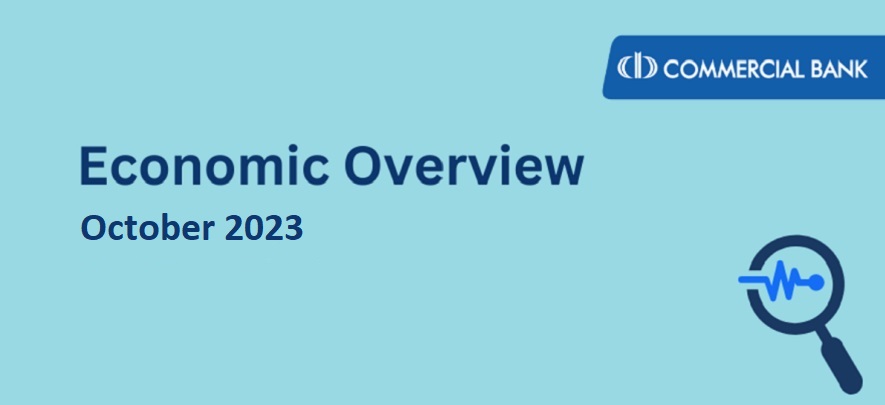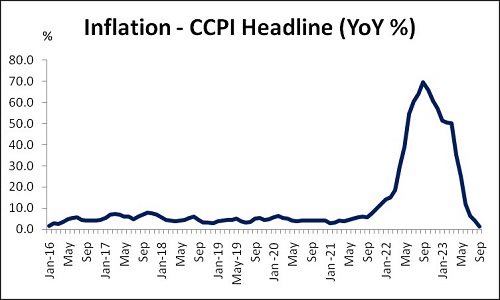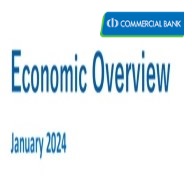Economic Overview: October 2023

ආර්ථිකය
29 week ago — අවම 11 කියවීම
Macroeconomic Overview
- Climate factors – adverse weather conditions could disrupt agricultural activities on the one hand and increase government expenditure on the other. This could directly hamper the economic growth.
- Several high-frequency indicators continue to show weak economic activity.
Economic Growth
Sri Lanka’s growth prospects will depend on the progress with debt restructuring as well as the continued implementation of growth enhancing structural reforms according to Dr. Richard Walker- the World Bank’s Sri Lanka Office, Senior Country Economist.
It is important to note that several high-frequency indicators continue to show weak economic activity. The movements of some of these indicators as outlined in Sri Lanka Development Update, October, 2023 - World Bank are given below:
- Total cement consumption (both locally produced and imported) declined by 32.5% (y-o-y) January–July 2023, reflecting the deep contraction in the construction sector.
- Electricity sales to industries also declined by 5.9% (y-o-y) in January to July 2023 as industrial output, including apparel, continued to shrink.
- Reflecting these continued challenges in industry, the Index of Industrial Production remained weak in the first seven months of 2023.
- The Manufacturing Purchasing Managers Index also remained lacklustre due to a shortage of new orders and overall weak demand.
- In contrast, the Services Purchasing Managers Index improved because of improvements in accommodation and personal services, reflecting a rebound in tourism.
Going forward some factors will help to improve the growth momentum. These factors include CBSL’s monetary easing cycle (resultant drop in interest rates), relative stability/slow depreciation of the rupee, expansion in disposable income due to low inflationary environment, eased import restrictions, enhanced supply conditions, increase in private consumption due to falling interest rates, recovery in tourism with positive spillover effects on industrial activity and services and expectations of enhanced credit to the private sector (supported by the decline in interest rates).
The key risks to growth include the following:
- Drop in global growth will have an adverse impact on SL’s growth (mainly through drop in demand for exports due to drop in growth in Sri Lanka’s key export destinations).
- A steep increase in the price of oil due to unrest in the middle-east and the war in Ukraine and /or other such reasons.
- Disruptions of supply chains due to war situations/pandemics.
- Climate factors – adverse weather conditions could disrupt agricultural activities on the one hand and increase government expenditure on the other. This could directly hamper the economic growth.
- Upcoming elections (2024) and possible delaying of investments due to the uncertainty. Further, there is also the possibility of deferment and/or derailment of some of the economic reforms.
Inflation

There are some factors that will contribute to a reduction in the rate of inflation. These include the favourable base effect and improvements in supply side factors. Further, the new CBSL act prohibits the CBSL from monetary financing (Section 86 of CBSL Act no. 16 of 2023). Besides, the Central Bank has inked an agreement with the Government to uphold a 5% inflation rate, with a permissible 2% variation.
The factors that could contribute to an increase in the rate of inflation will include a possible upward movement in oil prices, possible upward movement in global food prices (rice etc.), recent increases in utility tariffs, probable tax measures in the 2024 Budget (scheduled for November, 2023), demand pressures due to monetary easing and resultant decrease in interest rates, upcoming elections and resultant increase in government expenditure and monetary loosening and exchange rate pressures due to increased imports. Additionally, further price corrections may be required, especially in relation to fuel and energy pricing which could eventually translate into higher overall prices in the economy.
Interest Rates
Certain factors could contribute to a reduction in interest rates. These include CBSL’s current monetary easing cycle and the possibility of more policy rate cuts, drop in risk premia of government securities due to Domestic Debt Optimization (DDO), CBSL’s inflation target of 5% (present inflation is 1.3%, so there is further room for interest rates to come down), and CBSL imposing interest rate caps for lending instruments. Further, along with interest rate caps, the CBSL directed banks to reduce interest rates applicable for LKR lending products by a minimum of 250 bps (from July, 2023 levels) by the end of October, 2023 and by a further 100 bps by the end of December,2023.
A possible build up of inflationary pressures could also drive interest rates upwards. Interest rates may also have to be subsequently increased if imports rise more than the desired levels due to the low interest rates. Further, interest rates may have to be increased if a faster than anticipated depreciation of the rupee materializes.
At the T-bill auction held on 18 October, 2023 yields of 91 day T-bills decreased to 16.30% from 16.64% week ago (-34bps) while yields of 182 day T-bills decreased marginally to 14.94% from 14.96% week ago (-2bps). The 364 day T-bill yield dropped to 13.02% from 13.10% (-8bps). Meanwhile Rs 65bn worth of bills were offered at the auction and Rs 56.6bn worth of bills were accepted.
Exchange Rate
Some factors could contribute to an appreciation of the rupee. These include the anticipated release of the second tranche of the IMF-EFF and the expected Inflows from multilateral organizations (ADB, WB etc). These expectations have been strengthened by the announcement of the finance ministry of Sri Lanka that China EXIM bank has agreed to restructure debt amounting to USD 4.2Bn.
Further, improved foreign inflows from Tourism and Remittances are expected to strengthen the rupee. Additionally, despite the removal of import restrictions, the current account deficit is expected to narrow further in 2023, due to continued liquidity constraints, and remain benign thereafter with the recovery in tourism and remittances.
Some of the factors that could contribute to a depreciation of the rupee include possible inflationary pressure due to increased demand for consumption aided by easing credit conditions, rising oil and energy prices (supply cuts and tensions in middle-east), relaxation of all import restrictions other than private vehicles, and drop in export revenue due to drop in demand in key export markets. Further, due to CBSL’s year end Gross Official Reserves (GOR) target set by the IMF, the ability of CBSL to defend the rupee will be curtailed. Additionally, the CBSL may have to buy USD from the market to achieve the GOR target. Outflow of investor funds from emerging markets to advanced economies due to higher yields in advanced economies will exert downward pressure on emerging market currencies.
CBSL purchased USD 83mn from commercial banks on a net basis during September 2023. Meanwhile, CBSL had purchased USD 1.42bn from commercial banks during the first eight months of 2023 on a net basis to strengthen their reserve position.
The Central Bank middle rate recorded Rs.325.67 per US dollar as of 23 October, 2023.
Global Outlook
- China’s GDP was 4.9% larger in the third quarter than in the same period a year ago, a faster pace of growth than analysts had forecast. September’s growth in industrial output and retail sales also beat expectations. Officials downplayed talk of an economic recovery, warning that “the external environment is becoming more complex.” The property market is very fragile, as speculation mounts that Country Garden, the country’s biggest developer, may have defaulted on its dollar debt.
- Britain’s annual inflation rate held steady in September, at 6.7%. Food prices rose at the slowest pace since June 2022. The core rate, which excludes energy and food, eased to 6.1%. The Bank of England left interest rates on hold at its most recent meeting, and markets are betting it will do so again. “Let’s not get carried away,” Andrew Bailey, the bank’s governor, has said; the fight against inflation is not over.
- The euro zone’s annual inflation rate fell sharply in September, to 4.3%, the lowest level in almost two years. The core rate, which excludes food and energy, dropped to 4.5%. The mood music (prevailing feeling) from the European Central Bank is that it will keep its interest rates at the current high levels so that inflation drops to 2% by 2025.
- A rise in the cost of oil pushed Turkey’s inflation rate to 61.5% in September. The central bank has raised interest rates to 30% in a bid to tame prices.
- The rout in government-bond markets deepened, as investors bet that interest rates would stay higher for longer. The yield on America’s ten-year Treasury bond neared 5.0%, the highest since 2007. In Europe the yield on Germany’s benchmark ten-year debt rose above 3% for the first time since 2011.
- The humanitarian situation worsened in Gaza, where about 5,000 people have been killed, according to the Palestinians, amid Israel’s retaliation for the Hamas attack. Under mounting international pressure, Israel will allow food, water and medicine to cross from Egypt to southern Gaza, where the population has moved to take shelter.
Dr. Shanthikumar Fernando | Research & Development Unit | shanthikumar_fernando@combank.net
Disclaimer: This document has been issued for the information of the customers of Commercial Bank of Ceylon PLC only. The Bank and its employees do not accept any responsibility for the accuracy or completeness of the contents and any losses arising from any use of this material.
Commercial Bank ගේ පැතිකඩ බලන්න
Commercial Bank LEAP Team විසින් ලියන ලද අනෙකුත් ලිපි
Economic Overview: January 2024
14 week ago
Economic Overview: December 2023
20 week ago
මේ සතියේ වැඩිපුරම කියෙව්වේ
ප්රවණතා
Know Your Customer(s)...Really Well!
Business Development මිනිත්තු 10කට පෙර













අදහස්
කරුණාකර ඇතුල් වන්න හෝ ලියාපදිංචි කරන්න සාකච්ඡාවට එක්වීමට